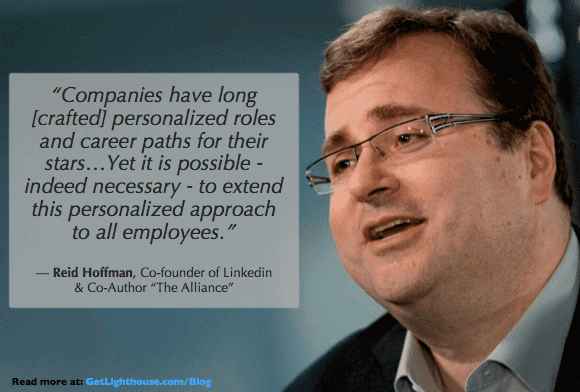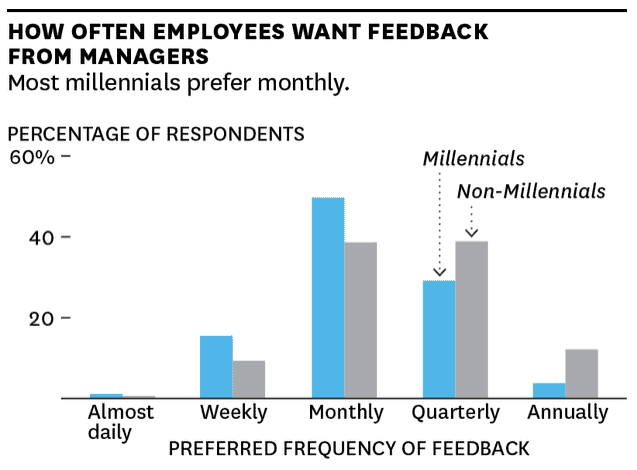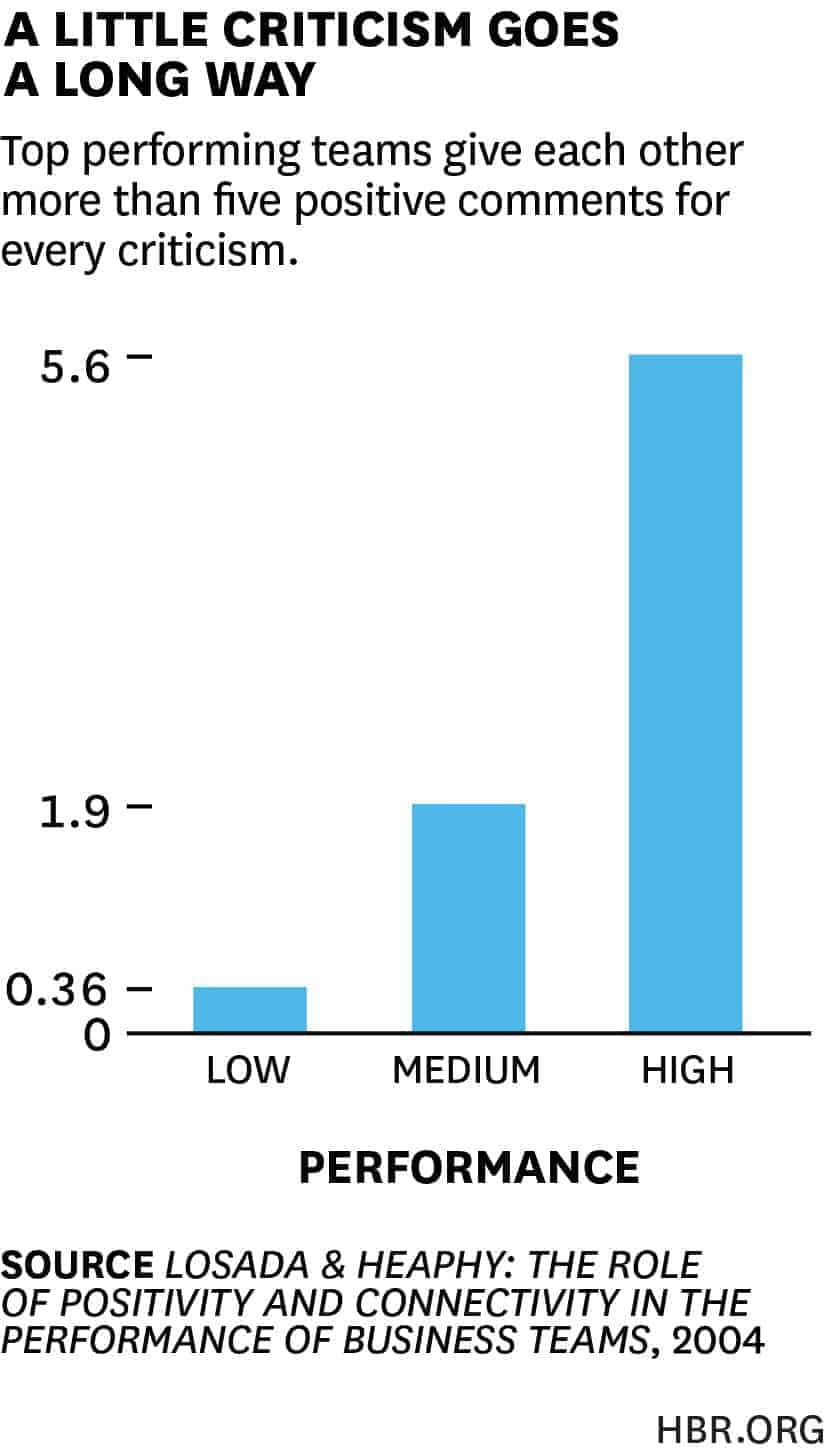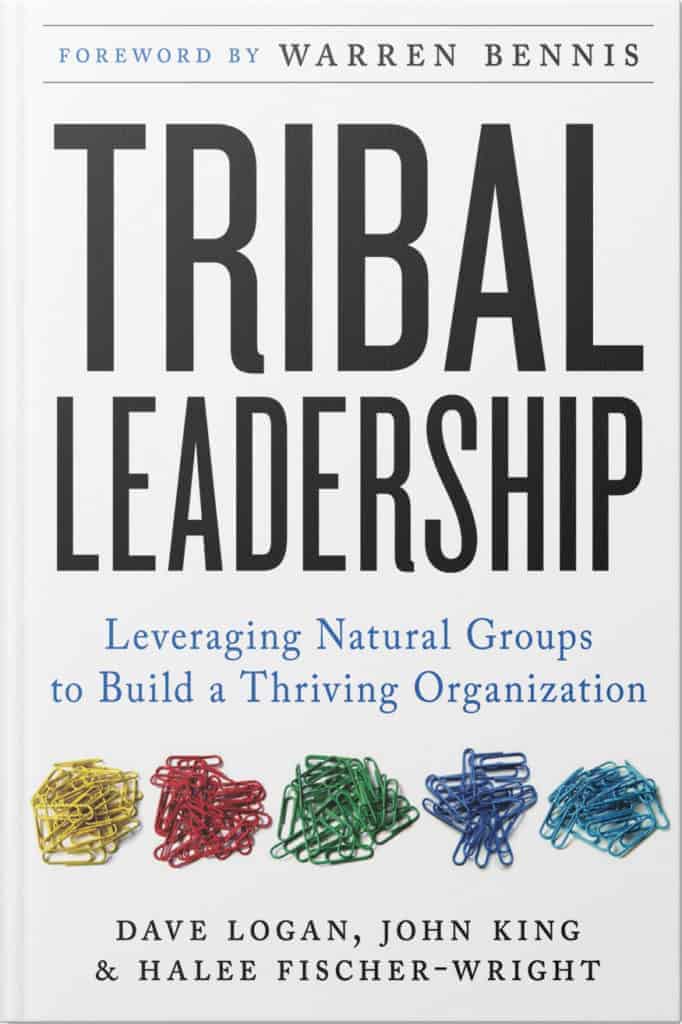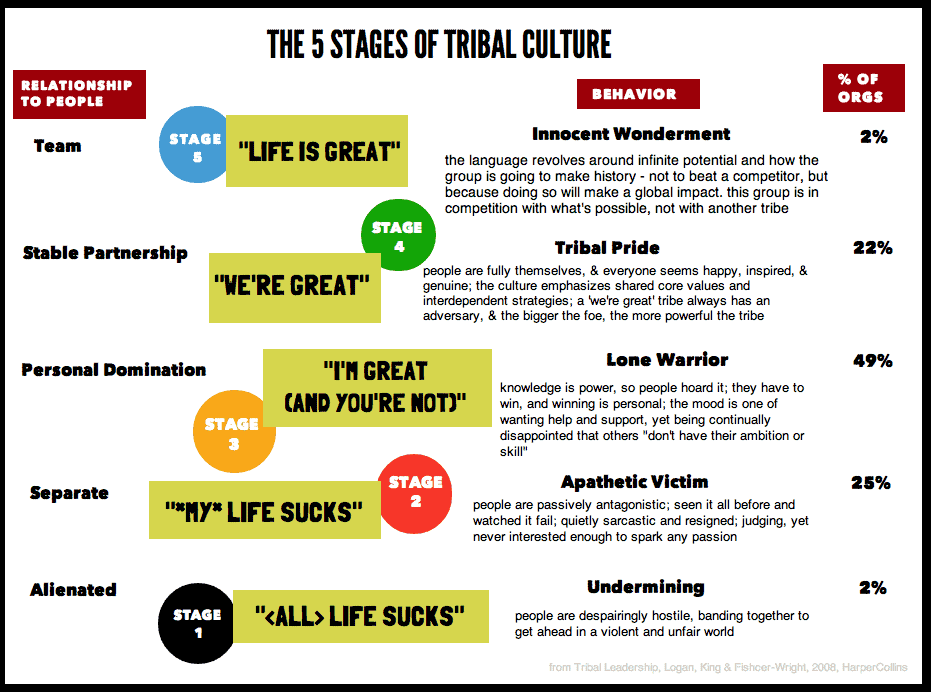Do you know what you're talking about in your next 1-on-1 with each of your team members?
What about next week? Next month?
How do you change your 1-on-1s for different team membership? What if they're on a leadership track vs. being an individual contributor?
Every 1-on-1 is different.
There are no hard-line rules for 1-on-1s meetings. Only through practice and experimentation will you find what works for each team member and situation with them.
1-on-1s work like most things in life: they require practice and adaptation to each situation. This insight is well captured by Google Health UX Manager Abi Jones in a recent tweetstorm about what she's learned from doing over 500 1-on-1s as a manager:
2. (um, these are not in any order)
— Abi Jones (@jonesabi) May 7, 2019
Good one-on-ones are like literally everything in life: they take practice. It's going to be awkward at first, but of you meet regularly, it'll start to feel normal. pic.twitter.com/RJ2rYtAVKo
Above are two of our favorite insights from her, and the other 70 or so tweets are also worth a read here.
And we agree with Jones's sentiment that there's a lot to understand and a variety of ways to have good 1-on-1s. However, it's not random.
In fact, there's a natural progression that your 1-on-1s will follow with most of your team.
Done right, the previous stage of your 1-on-1s with someone lays a foundation that builds towards the next level. This way, you can make continual progress with team members as opposed to going stale and running out of things to talk about (and reducing the effectiveness of your one on ones as a result).
To do that, you need to take command and guide the agenda of your 1-on1s.
The coach dictates what happens at practice
Who decides the agenda, you, the manager, or your team member?
While your first instinct may be to think, "their meeting, their agenda", there's much more nuance to being a great manager in these meetings. App Sumo CEO Ayman Al-Abdullah captures this well with his pithy statement in his tweet:
Every great management book says that the employee should set the agenda for the 1:1. I never understood that concept. If you're the coach, you should dictate what happens at practice.
— Ayman Al-Abdullah 🧱 (@aymanalabdul) November 18, 2017
It's important that team members be given the opportunity to contribute to the agenda of their 1-on-1s for pressing matters they want to talk about. However, you should also prepare things you think would be important to discuss. Based on this sentiment, here's how I responded when a fan of the Lighthouse blog mentioned us in the responses to Al-Abdullah's tweet:
I agree with sentiment and find in practice most managers have to set it at first, then managers team members will bring things for a few months, then once comfortable for the most part as suggested managers have to plan a lot of it.
— Jason Evanish (@Evanish) November 19, 2017
As you get more comfortable with your team member, you'll find there is a need and opportunity to talk about a variety of things in your 1-on-1s.
As this happens, where do you go? What do you talk about?
Do you understand the different "stages” you're at with each team member to figure out what that next level is, or are you at a loss about where to direct the conversation?
With this in mind, we want to provide you a general framework you can use to help you think about the process of leading your team members through 1-on-1s over hopefully many months and years of working together.
Your 1-on-1 Development Path: How to Always Make the Most of Your 1-on-1s as they Progress Over Time
We've talked a lot about 1-on-1s, but never truly broken down the process of taking team members through 1-on-1s over time.
It can be confusing when you start having regular 1-on-1s with your team. It takes time to figure out what to talk about, draw information out of your team, and understand the nuance of when to drive versus let them lead.
It's great when they take command and bring their own topics, but it never lasts. Eventually, the responsibility is once again placed on your shoulders as their leader to guide those 1-on-1s in a way that's continually beneficial for both you and them.
Below is a framework for leading your team members through 1-on-1s, each point a "stage” that together forms a kind of 1-on-1 development path that will help you make progress no matter where you're at with your relationship with them.
Also, it's important to note that throughout you should be bringing a healthy dose of curiosity. Your role in each 1-on-1 will almost always be defined more by the questions you ask than anything you say, so remember the value of staying curious.
Let's begin.
1) Start by building a foundation of trust & rapport
Before doing anything else, if you're just starting out with 1-on-1s, you need to begin by building trust and forming a clear understanding of what 1-on-1s with you will be like so they know what to expect.
Trust is the foundation of a good working relationship, and essential for healthy 1-on-1s.
Without a solid foundation of trust, it's very difficult to give or receive feedback, or get them to open up about potential issues. Think about what you tell a friend versus a stranger.
That's why building rapport is so important for effective 1-on-1s: it's the easiest way to build that foundation of trust.
Start by building rapport
By building rapport with your team members, you're connecting with them on a basic human level, something we all crave. Camille Fournier, author and former CTO of Rent The Runway, described this idea on her blog, something which she calls "relatedness.”
"As a leader, you will lead people who want Relatedness in their job.
They want you to know about their family, their hobbies. They want to chat with you about their weekend, their trips away. They want to get lunch sometimes.”
The easiest way to start building trust is by asking rapport-building questions in your first few 1-on-1s, such as:
- What do you like to do in your free time? What are your hobbies?
- How do you feel your work/life balance is right now?
- What's one thing we could change about work for you that would improve your personal life?
- What part of your job do you enjoy doing most? Why do you enjoy it?
*Learn more about how to build rapport with your team by reading 82 Ways How to Build Rapport With Anyone You Work With.
Tell them what to expect in their 1-on-1s with you
One of the most important things you can do as a leader is manage your team's expectations. You don't want to surprise them.
1-on-1s are definitely something you want to help your team understand what to expect, so plan to tell them about your intentions with the meeting and how it will help them.
When you're managing a new team, there are questions you can ask that will make it easier to build the foundation we've talked about and show them what to expect from your 1-on-1s going forward.
Here are some great questions to ask your direct reports to give them a better idea of the kinds of things you'll be talking about in your 1-on-1s:
- What have your past managers done that you'd like me to also do or not do?
- What are your career goals and where did your last manager leave off with them?
- What's something you do regularly outside of work that's really important to you?
These kinds of questions help you understand what motivates and drives them, and helps you better manage and motivate them. Sometimes it's things to avoid, and other times it will be things to make sure you do. Either way, you won't know them unless you take the time to ask.
To learn more about how to make the most of each of these questions, as well as more questions for when you're managing a new team, read what questions to ask new team members.
And if you want a step-by-step set of instructions for how to start 1-on-1s with your team, including a template email you can use to tell them about 1-on-1s, read our Manager's Guide: How to start 1 on 1s with your team.
2) Listen and ask a variety of questions
Now that you've begun to build trust and lay a foundation, it's time to hand the wheel over to them for a while.
The practice of listening and asking good 1-on-1 questions will always be a part of your 1-on-1s, so it's important to invest time into both. However, in the beginning, it's especially important, because you are getting to know them.
The key is that you want to show them you're interested in them: in their ideas, their feedback, and their perspective. Develop a natural curiosity for them and what they have to say.
Ask the right questions
As your team member gets comfortable with having 1-on-1s with you, you should find they'll start bringing some things to talk about. When they do, take the time to ask follow up questions to really understand what they're trying to tell you.
With the right questions, you can respond effectively to issues that are brought up and guide them to productive resolutions, such as:
- What's a recent situation you wish you handled differently? What would you change?
- Or: What could I do as a manager to make your work easier?
Prepare questions in advance on each team member's 1-on-1s so you always have them on hand, no matter what direction the conversation goes. For example, if you feel there's ways you could improve them or their work you'd ask questions like:
- What's an area of your work you want to improve?
- Who would you like to work more often with? Why?
- Are you happy with your recent work? Why or why not?
- What part of your job do you wish you didn't have to do?
Each of these questions helps you learn more about them, but instead of just focusing on rapport, you're now getting them to open up about their ideas and share their feedback as well.
For more great 1-on-1 questions to help you be ready for any topic of discussion with your team, read our posts:
- 102 One on One Meeting Questions Great Managers Ask their Teams
- 31 Questions to Ask Remote Employees to Better Support Them
Become a great listener
It's not enough to just ask good questions, you need to actively work on becoming a great listener as well.
Many people develop the habit of talking a lot then simply waiting for their next chance to speak. Great leaders consistently show the opposite quality: listening more than they speak.
Practicing active listening is a great way to make sure you're not just hearing their words, but truly understanding what your team member is saying when they speak.
To practice active listening most effectively, when your team member finishes covering a topic, reflect on what they said and repeat it back using your own words and ideas to describe it. By doing so, you can be sure you understood what they said, because they'll either nod in agreement, or clarify what you misunderstood.
This is powerful because you're clarifying what they meant. It allows you to make sure you're fully understanding them, improving the quality of your communication in the process. Without this level of active listening, misunderstandings can arise, leading to issues that could have easily been avoided.
Asking the right follow up questions, and preparing other questions to expand the scope of your 1-on-1s are great ways to keep your 1-on-1s high quality after you've built a foundation of rapport and trust.
3) Help them with their career goals
At this stage, you've probably been having 1-on-1s for a while. They've started bringing some of their own topics to discuss, and you've been asking more questions getting them to open up as you build rapport, trust, and learn about them.
Next, start working with them on their career growth. Few things are as motivating as feeling like you're making progress on where you want to go long term. Once you have the foundation with your team member, it's the perfect time to dive into their career.
Discover their long-term goals
Start by learning what their long-term career goals are. From there, you can begin to connect the dots between them and their current work.
Ask your team members questions such as:
- "What work are you doing here that you feel is most in line with your long term goals?”
- "What are your long term goals? Have you thought about them?”
- "Could you see yourself making progress on more of your goals here? What would need to change?”
Alternatively, if you want to ask a bit more informally, you can ask this line of questions that former Next Big Sound CEO David Hoffman has used:
"Imagine it's 10 years from now and there's a party celebrating you and your accomplishments . . .
Who is there? What music is playing? And what is the accomplishment everyone is there to celebrate?”
Regardless of how you ask, the important thing is finding out what their goals are. One day, they'll be doing that at your company, or they'll go find another job that will allow them to do those things.
Once you do discover what their goals are, work backward. Help them to make progress toward that major goal, and stay motivated as they wait to build all the skills for that new role, promotion, or tasks.
To learn more about setting up a career development plan for your team, read: The 3 Questions Every Manager Struggles with Making Career Development Plans and if you have limited promotion options, check out How to grow your employees when you can't promote them.
4) Coach your team to bring out their best every day
As you continue to listen and ask questions, building trust, learning more about them, and helping them make progress on their goals, you become more than a manager to them: you become their coach.
That trust and rapport you've been building with them all this time now becomes critical. Without it, they wouldn't be willing to listen to your feedback, making coaching them impossible.
Unfortunately, real-time feedback apps don't work, so make your 1-on-1s the time for giving your team members both detailed feedback and praise. This gives you plenty of time to dig into the specific situations, make sure they understand what you mean, and talk about what they should do differently going forward.
It also lets them ask you questions to make sure they understand what they should do more or less of, and why.
Monthly feedback is a win-win
Just like talking about their career goals, you'll want to space out some of these discussions. Hopefully, they do their work well enough to not need feedback every week, so roughly once a month can work great in most situations.
Monthly coaching gives you time to build up a few examples, and see the impact of either the positive thing you want to praise, or the feedback of what they must change. All of that information you can then share in their 1 on 1 with you to maximize the impact of each bit of coaching you do.
Best of all, giving feedback roughly once a month is also the timing that employees want most according to a recent survey:
Be mindful of your praise-to-criticism ratio
It's easy to criticize a team member who isn't doing something they should be or needs to improve. It's much harder, though, to keep up an equivalent stream of praise to balance that negative feedback out.
A recent study discussed in the Harvard Business Review, uncovered that teams who had a 5:1 praise-to-criticism ratio outperformed more negative teams significantly:
How often are you criticizing each of your team members? How often are you praising them? It's an important question to ask, and could explain why some team members are responding better to you than others.
For example, Google Health UX Manager Abi Jones talked about the importance of giving more praise and how she uses the SBI framework in a recent tweetstorm:
7. When you're not listening, one thing you'll do is provide feedback.
— Abi Jones (@jonesabi) May 17, 2019
Telling people what they did a great job on is the *most important* form of feedback.
The SBI model helps me make feedback useful:
S - Situation
B - Behavior
I - Impact
She gave an example of how to use the framework to offer more effective praise:
(you're not supposed to lead with "great job" but putting the praise at the end makes me feel like psychopath)
— Abi Jones (@jonesabi) May 17, 2019
Anyways...
You probably practice giving negative feedback ALL THE TIME.
Try giving more positive feedback.
By balancing out your praise-to-criticism ratio with more praise than you're probably giving now, you can better motivate your team. You will be encouraging the right behaviors, so you get more of what you really want from them.
To learn more about the power of effective praise, read:
- The Ultimate Workplace Praise Guide: How to be More Positive at Work and Give More Praise to Your Team
- 5 Ways to Give Effective Praise to Motivate Your Team
Use PLA to provide constructive feedback
In addition to creating a better balance between criticism and praise, make sure you're offering constructive feedback as opposed to just mindlessly criticizing. Your feedback should be well-thought-out and presented in a way that they'd be most likely to absorb it.
Use the Prepare-Listen-Act model to make sure you're effectively providing constructive feedback:
- Prepare: Think about the feedback you're planning to provide. Ask yourself questions such as, "What is the context?” and "What do they need to do differently going forward to address this?”
- Listen: Listen to their side of the story. Make sure you have all sides, and all the facts, before you assume what's going on and give your feedback.
- Act: Be specific in describing next steps. "What exactly needs to change?" They need to know what you expect them to do differently going forward.
With this model, you can ensure you're offering feedback that is both accurate and effective. The last thing you want to do is offer rushed feedback, or not establish what action needs to be taken. If you do that, you could end up talking about the same issue a month later, making them feel like they're not making any progress.
Coaching your team is a fundamental habit of great managers, and your 1-on-1s are the perfect place for it to happen. However, you need to build a foundation first. This is why we recommend you focus first on building rapport, asking questions to expand your discussions, and understanding their career goals, then working in regular coaching.
Everything builds on each other, as you'll find that you can often tie feedback to their career goals ("if you want to get that promotion, it's important you master this"), and as we mentioned before, you're more likely to accept feedback from someone you trust.
5) Next, work on improving the work environment and your team.
To get to this point, you've invested a lot of time into your team member. You've developed trust & rapport, helped them establish a career development plan, and even begun coaching them. This already puts you in the top 10% of managers. But if you're reading the Lighthouse blog, we know you aspire to be the best.
Now, you should start digging for valuable feedback from them that will help you improve the team and the overall work environment.
To that end, you can use questions like these to help uncover valuable insights from them that you wouldn't have been able to discover on your own:
- How could we change our team meetings to be more effective?
- Are there any meetings you feel you shouldn't attend, or wish you did that you're left out of?
- Do you feel like you're on the same page with the team? How often do you think you need meetings to ensure you stay that way?
- Is everyone pulling their weight on the team?
- Who is kicking ass on the team? What have they done?
And you can also ask questions about the work environment as a whole:
- If you were CEO, what's the first thing you'd change?
- Do you think our company is loyal to its employees? Why or why not?
- Are there any aspects of our culture you wish you could change?
These questions can help you uncover friction on your team. Where is time being wasted? Where are there opportunities to be better?
Ask these across your team and you'll likely find patterns. Many will have problems with the same jerk on your team, or the same meeting will be a waste of time in most people's eyes. This gives you the chance to identify and fix these things, as well as collaborate with your team on how to solve them.
Use 1-on-1s to level-up your tribe
In Tribal Leadership: Leveraging Natural Groups to Build a Thriving Organization, Dave Logan, John King, and Halee Fischer-Wright, describe tribes as the collection of small towns that make up a larger organization.
Your team, and even smaller groups within your team, can form various tribes that are part of the company you all work at. As a leader, it's important to recognize what these tribes are, and how they're doing working together.
According to Logan and his co-authors, tribes have 5 different levels depending on how developed they are. Just 2% of organizations occupy the highest level, Stage 5:
1-on-1 questions for improving tribal leadership
How does this play into your 1-on-1s? Logan and his co-authors say these are some of the most basic things that need to be addressed to get tribes to stage 5 (the highest level):
"Perform regular oil changes with the team. In this process, she should lead a discussion about
(1) what is working well,
(2) what is not working well, and
(3) what the team can do to make things that are not working well, work.”
The most effective place to uncover this information is in your 1-on-1s with each member of your team. This ensures candor due to the privacy of the meeting. It can then also help you understand where some on your team may be at one Tribal Leadership Stage, while others are at a higher one.
As you ask these questions, watch the language they use closely. A key indicator of each stage of Tribal Leadership is the language they use. Your goal should be to improve things so your team is saying more any more "we're great" and "life is great" instead of "life sucks." That only happens when you listen, learn, and act together.
6) Finally, keep growing your people and train some of them to be leaders, too.
At this point, your 1-on-1s with each team member should largely be a well-oiled machine. Continue to talk career goals with your team members every 3-4 meetings, support them, uncover issues, improve the work and team environment, and leave space open for their talking points.
Most importantly, get a feel for what's right for each individual team member. Everyone is different and while one person might need a lot of guided feedback and follow-up, another may take your comments and run with them, handling it on their own.
Leadership is not one-size-fits all
As NBA legend Bill Russell wrote in his biography, Second Wind about former Celtics head coach Red Auerbach, the trick is to learn those differences and lead each member of your team based on their personality:
"He knew he had to yell at Heinsohn shrewdly and personally, whereas he bullied Satch and Nelson…with KC Jones, you had to be honest and leave him alone; he'd do the rest.
I watched Red spend time with the Celtics who played the least…he always talked to them enough to remind them how important substitutes are to a team. He tended to be more supportive of them than of his regulars.”
On your team, just as Auerbach's multi-championship Celtics, everyone needs to be led a bit differently. The more 1-on-1s you have with each team member, the more you'll be able to feel out those differences and figure out the best way to help each person succeed. Your 1-on-1s will turn out to be as different as each person on your team.
Use your 1-on-1s to train leaders
If your team is all high performing, growing in their careers, and reaching high stages in Tribal Leadership, you're going to get noticed. You're going to get more budget, more head count, and people are going to want to join your team.
With that will come new challenges. You'll be onboarding and starting 1-on-1s with new people, dealing with new communication overhead, and eventually reaching the upper limit of how many people you can directly manage. As you can see in the image below, the lines of communication grow geometrically as you add headcount.
When your team becomes too large for you to handle everyone directly (this happens at roughly 10-12 direct reports), you have no choice but to develop leaders under you.
Develop leaders as part of your 1-on-1s
1-on-1s are a great place to begin developing leaders. First, it's private so you can introduce the idea you think they have potential, and make sure they're interested. Some people are very happy being individual contributors, and you'll only create bad managers if you force them to do it for the wrong reasons. For them, keep helping them in the ways mentioned in steps 1-5 in this post.
Meanwhile, if they do want to become a leader, you can use 1-on-1s to coach them on the skills needed, start easing them into the role, and work on the important shifts in thinking they will need.
You can also give them small projects like mentoring an intern, or taking the lead on a project or initiative so they can get their feet wet. Again, your 1-on-1s will then be priceless, as you can check in semi-regularly how those new efforts are going.
As they achieve more success, you can start looking at them taking over managing some of your direct reports, freeing your schedule to focus more on them and other leaders you're creating.
Whatever route you take, regular 1-on-1s are the best way to begin developing leaders. They give you a way to help mold their thinking to shift from individual contributor to multiplier less jarring. And best of all, by leading them through all these stages, you're setting a fantastic example of how to be a manager. You'll know what to teach them, and they'll know the behaviors to emulate to succeed like you have.
You can learn more about training some of your team members to become leaders with our posts:
- Learn How to Develop Leaders;
- Everything you need to know about Skip Level Meetings;
- Why You Should Promote from Within, and the 10 Pitfalls to Avoid When Promoting from Within.
Take full advantage of the power of 1-on-1s
1-on-1s are so much more than "how are you doing?" and "what do you want to talk about?"
You can use them to create an effective feedback loop, motivate your team, improve their engagement, and develop leaders, among so many other things.
However, you can only do that if you invest the time necessary to stick to consistent 1-on-1 meetings and learn about each team member so that you can personalize how you lead, motivate, and coach them.
Consider the framework we covered as a guide to help you effectively evolve 1-on-1s with your team. While they're not hard and firm steps, the order is intentional in that one helps make the next one easier and better:
- Build trust and show them what 1-on-1s can be
- Listen and ask a variety of questions
- Help them grow in their careers
- Coach them through motivating praise and effective feedback
- Work on improving the work environment and the team as a whole
- Develop leaders to help you as your team grows beyond what you can manage yourself
Everyone moves through these stages at a different pace. As a leader, the best thing you can do is keep these in mind, so you always have fresh ideas and questions to bring to everyone's 1-on-1s. When you use them well, you'll find you'll always have more to talk about, and the conversations will be great and productive.
Are you and your managers wasting their 1 on 1s?
There is no greater investment to make in your team than having 1 on 1s. Yet, done poorly they’re a huge waste of time.
That’s why we made the 1 on 1 Master Class. You and your fellow managers learn step by step how to supercharge these meetings to motivate your teams, fix problems, coach your people, and much more.
You can learn how Lighthouse Lessons can help your leaders like we helped SeedBox Technologies by signing up here.











